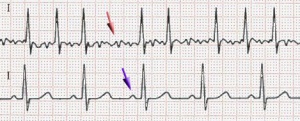Atrial fibrillation: различия между версиями
Wikiadmin (обсуждение | вклад) |
Wikiadmin (обсуждение | вклад) |
||
| (не показана 1 промежуточная версия этого же участника) | |||
| Строка 12: | Строка 12: | ||
It is distinguished paroxysmal and permanent (or chronic) forms of atrial fibrillation by the nature of the current. [[Paroxysm of arrhythmia|Paroxysms]] of fibrillation last from a few seconds to several days. Short paroxysms often end spontaneously. | It is distinguished paroxysmal and permanent (or chronic) forms of atrial fibrillation by the nature of the current. [[Paroxysm of arrhythmia|Paroxysms]] of fibrillation last from a few seconds to several days. Short paroxysms often end spontaneously. | ||
| − | Atrial fibrillation is caused by atrial extrasystoles or impulses of pacemaker that fall into the vulnerable period of the cardiac cycle, and also, in isolated cases, by [[Ventricular | + | Atrial fibrillation is caused by atrial extrasystoles or impulses of pacemaker that fall into the vulnerable period of the cardiac cycle, and also, in isolated cases, by [[Ventricular extrasystoles (premature ventricular contractions)|ventricular extrasystoles]] in the presence of additional atrioventricular pathways, capable of retrograde conduction. |
If an attack of atrial fibrillation develops, you should urgently seek medical help, since this arrhythmia should be stopped within the next 48 hours (!). After this period, there is a sharp increase in the risk of intracardiac blood clots and related complications (stroke). | If an attack of atrial fibrillation develops, you should urgently seek medical help, since this arrhythmia should be stopped within the next 48 hours (!). After this period, there is a sharp increase in the risk of intracardiac blood clots and related complications (stroke). | ||
| + | |||
| + | This pathology can be detected using ECG Dongle [https://cardio-cloud.ru/good/1], ECG Dongle Full [https://cardio-cloud.ru/good/2] and «Serdechko» [https://cardio-cloud.ru/good/12]. | ||
Текущая версия на 11:52, 31 марта 2021
Atrial fibrillation is a rapid irregular atrial contraction, in which the frequency of their contractions exceeds 350 beats per minute. The appearance of fibrillation is characterized by irregular contraction of the ventricles.
Atrial fibrillation is the most common form of supraventricular arrhythmia, at which the atria contract chaotically at a frequency of, as a rule, 400-600 beats per minute without coordination with the ventricles of the heart.
The signs of atrial fibrillation are the same as in other arrhythmias:
- feeling of interruptions in the work of the heart;
- feeling of "bubbling" in the chest;
- syncope;
- darkening in the eyes.
It is distinguished paroxysmal and permanent (or chronic) forms of atrial fibrillation by the nature of the current. Paroxysms of fibrillation last from a few seconds to several days. Short paroxysms often end spontaneously. Atrial fibrillation is caused by atrial extrasystoles or impulses of pacemaker that fall into the vulnerable period of the cardiac cycle, and also, in isolated cases, by ventricular extrasystoles in the presence of additional atrioventricular pathways, capable of retrograde conduction.
If an attack of atrial fibrillation develops, you should urgently seek medical help, since this arrhythmia should be stopped within the next 48 hours (!). After this period, there is a sharp increase in the risk of intracardiac blood clots and related complications (stroke).
This pathology can be detected using ECG Dongle [1], ECG Dongle Full [2] and «Serdechko» [3].

